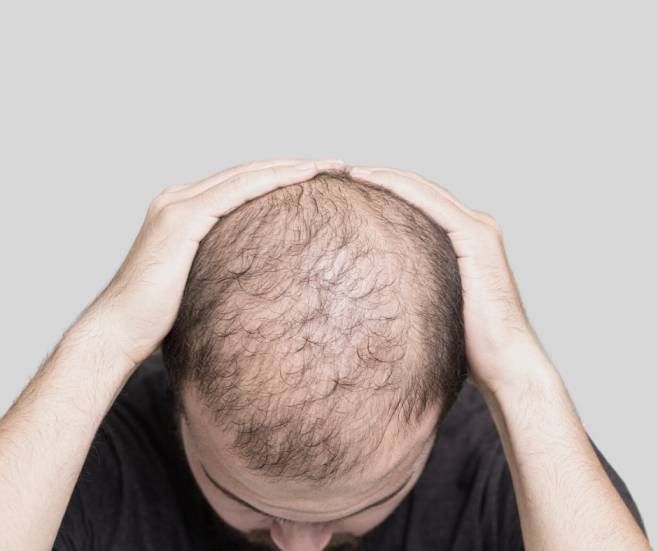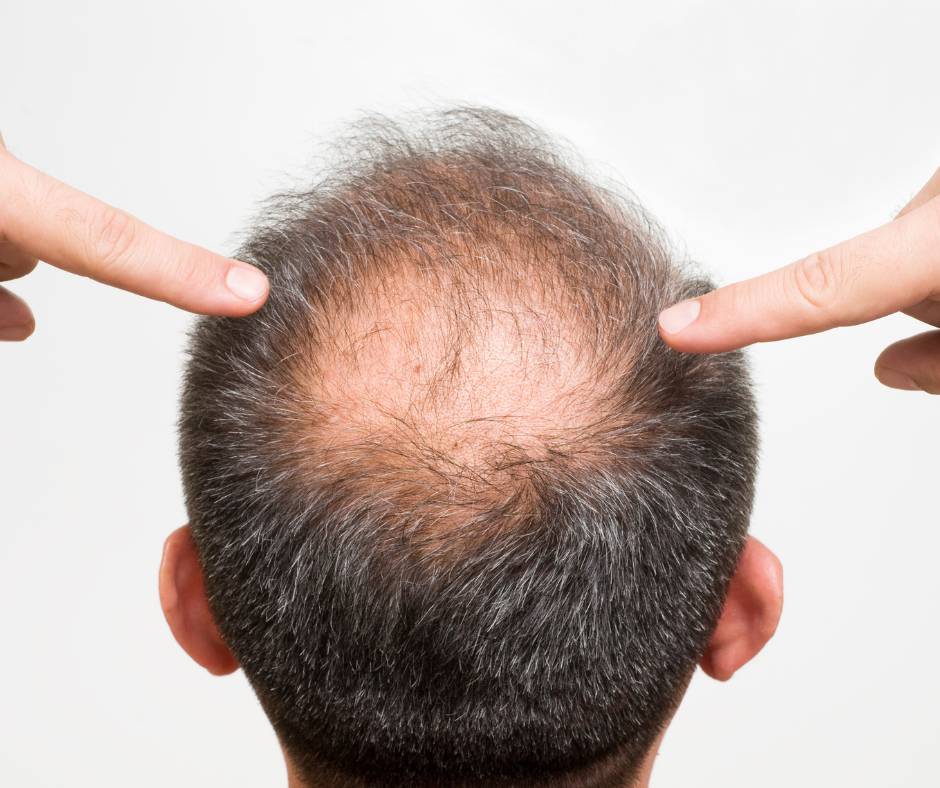As you age, testosterone becomes a very scarce commodity. This leads to a reduction in bone density, wrinkly skin, and slow wound healing. One of the most common problems seen in men is hair loss. According to Healthline, in America alone, about 35 million men are enduring some level of hair loss. But is it linked to testosterone? Read on to find out more.

Hairloss in Men
Hair loss that is linked to testosterone is known as androgenic alopecia. It’s also commonly known as pattern baldness or MPB (Male Pattern Baldness) in short. This is the most common hair loss experienced by adult males and presented to a male hair loss specialist. The onset of MPB (Male Pattern Baldness) is mostly noticed starting from the twenties. In some instances, it can take several years for the progress to be noticeable. This problem usually starts with thinning of hair and receding of the front hairline. It is caused by a variety of factors, of which testosterone plays a role.
DHT and Hair Loss
Dihydrotestosterone, also known as DHT short, is a hormone made from testosterone. The conversion is facilitated by an enzyme known as 5-alpha reductase. DHT can also be converted from DHEA. This is a hormone that is more abundant in women. DHT can be found in the skin, prostate, and hair follicles. Its actions and how it interacts with hair follicles are thought to cause hair loss. The hormone also has some significant action in the prostate. Without DHT, there will be abnormal development of the prostate. If the hormone is too high, men can end up with benign prostate hypertrophy.
Genetic Factors and Testosterone
Baldness is not caused by the amount of testosterone present or the levels of DHT. It only occurs if your hair follicles are sensitive to these hormones. Sensitivity to DHT or testosterone is determined by your genetic makeup. Some men have an active AR gene that makes their hair follicle receptors sensitive to testosterone and DHT. If you have highly sensitive receptors, they can be triggered by even the smallest DHT amounts. This causes hair loss. There are other factors apart from your genetic makeup that can contribute to hair loss. This includes stress, age, and diet. However, genes play a more significant role. You will find that men who have close relatives who experience hair loss have a higher risk of developing the same problem.
Testosterone does play a role in hair loss. However, it only causes issues in men whose genetic makeup is already linked to baldness. Do you have more questions about male pattern baldness or how testosterone can cause hair loss? Get in touch with our male hair loss specialist today and we will answer your questions.

6 Benefits of minimally invasive Bio-Integrated FUE
Men and women suffer from thinning hair, which interferes with their self-esteem and quality of life. Hair transplants are a method to restore lost hair. The procedure takes hair from areas of your scalp that still have hair or from other parts of your body and places it in the thinning or balding sections of your scalp.
Hair transplants are one of the most effective ways to restore lost hair and are usually far superior to over-the-counter hair restoration methods.
Looks Studio Surgeons is proud to offer the most advanced 5th-generation hair transplant technology. Bio Integrated FUE method is minimally invasive but yields natural results. The process involves moving groupings of one to four hair follicles to the area needing coverage.
Here’s why you should consider Bio Integrated FUE and its minimally invasive approach to restoring your head of hair.
1. No scarring
During a Bio Integrated FUE transplant, very small samples of follicular units are removed and replaced with the thinning area. This means you avoid the linear scars that often occur with more invasive hair transplant methods.
2. No downtime
You can return to your normal activities the day after your Bio Integrated FUE procedure. This means little lost work or time off from social engagements. You may have some scalp soreness for a day or two after your procedure, but over-the-counter pain medications are usually sufficient in treating this pain.
3. A permanent solution
A hair transplant offers a permanent solution to your hair loss. Hair that’s transplanted lives and grows according to its normal life cycle. Bio Integrated 5th generation FUE is a one-time procedure, with no need for multiple touch-ups or maintenance visits.
4. Does away with balding
This should be an obvious benefit! Men and women who are self-conscious because of hair loss get great results from a minimally invasive hair transplant. Hair no longer falls out in areas treated with a hair transplant. You can say goodbye to receding hairlines and bald patches. Think of how good you’ll feel (and look) after a Bio Integrated FUE procedure.
5. No maintenance
Your transplanted hair acts just like regular hair. You don’t have to use special shampoos, treatments, or potions to keep your hair growing and maintain hair density. Bio Integrated FUE is a one-time procedure.
6. Little discomfort
Bio-integrated FUE uses technology that makes the procedure quick and that produces superior results. People report little discomfort.
In Bio Integrated FUE an ice cell technology is been involved to store grafts for optimum graft survival and helps the graft to retain all the properties.
If you’re dismayed by thinning hair or balding, we here at Looks studio offer a solution. We want you to feel good about the way you look — and this includes your hair.
Read More – Hair Transplant Cost-Need To Know
